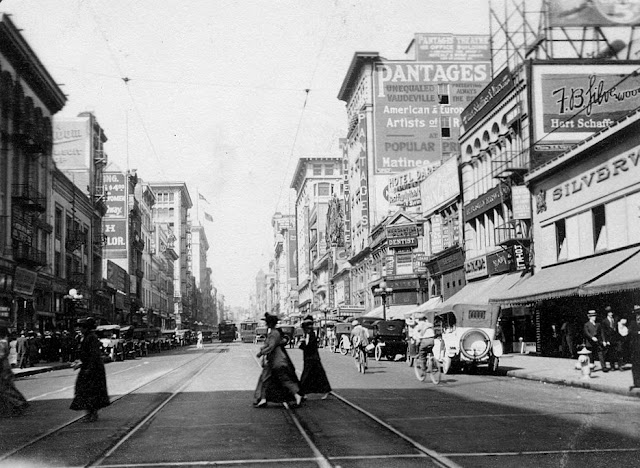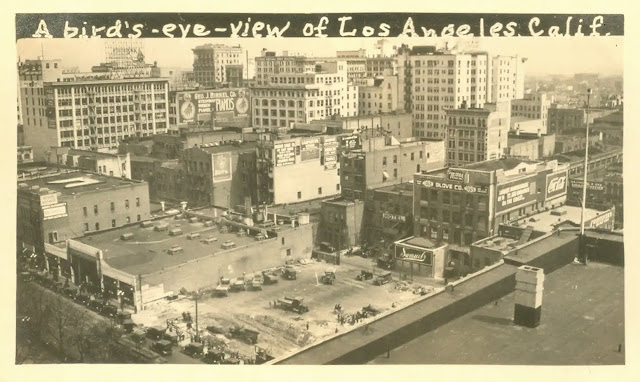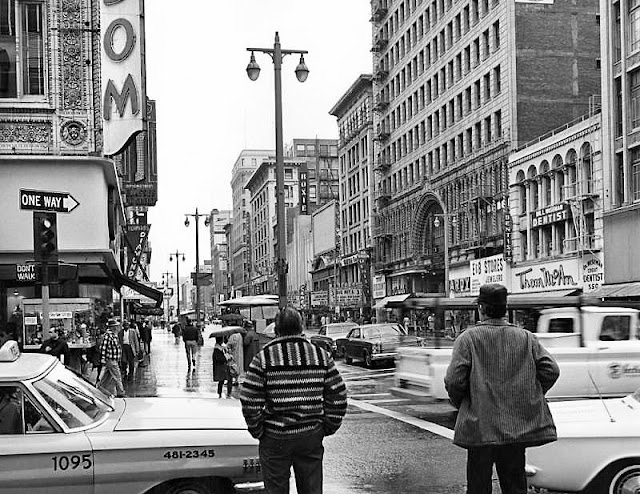534 S. Broadway Los Angeles, CA 90013 | map |
The Arcade Theatre pages: history | vintage exterior views | recent exterior views | lobby areas | auditorium | stage | basement | office building |
1910 - A view of the top of the newly completed Pantages building as we look northwest. The theatre's opening was September 26. Just to the right we see the roof of Clune's Broadway (later renamed the Cameo) with the sign frame constructed but with no signage installed yet. It opened October 10. It's a C.C. Pierce photo from the California Historical Society that's on the USC Digital Library website.
c.1910 - This lovely view looking northeast was probably taken not much after the Pantages opened. The theatre is on the far right, a bit down from the top. That's Pershing Square (called Central Park at the time of the photo) on the left with the Philharmonic Auditorium in the upper left. Thanks to Noirish Los Angeles contributor Ethereal Reality for spotting the photo on eBay and including it on his Noirish post #2388.
c.1910 - A slice from the right edge of the previous photo with the Pantages up near the top. Down at the bottom it's a rare view of the Bandbox Theatre, 608 S. Hill St.
c.1910 - A view looking south from 5th St. in the William M. McCarthy Photograph Collection in the California State Archives. We get a sliver of the Pantages over on the left. It's cataloged as Album 5, Photograph 283. The collection includes over 3,000 photos taken by William and his wife Grace all over the country from about 1905 until 1938. Thanks to Kim Cooper and Richard Schave for posting about the newly digitized collection on their blog Esotouric.
1911 - A view north on Broadway toward the Pantages. At the right it's the Orpheum (now called the Palace) under construction. It's a Warren Dickerson photo in the collection of the L.A. County Natural History Museum. The building in the distance with the pointed roof is City Hall.
1912 - We don't see much of the facade but that's the marquee of the Pantages jutting out in this view north. Each of those art glass panes on the side of the marquee had one letter of the "Pantages" name. Just beyond it's Clune's Broadway, later renamed the Cameo. Note top of that theatre's distinctive curved facade in the upper center of the image. The merchants on the far right are part of the Mercantile Place development. That area would get replaced by the Arcade Building in 1923.
1912 - A terrific view from the east. The building on the left was at the northwest corner of Spring and 6th with 6th St. seen on the left edge of the image. In the center it's Mercantile Place, cutting between Spring and Broadway. Note the stage end of the Pantages, with its smoke vents, just right of center. That's the Cameo to the right of the Pantages and the Philharmonic Auditorium in the distance on 5th. Thanks to Beth Harness Marshall Horwitz for sharing this image, and several others, in a post on the Images and Memories of Los Angeles Facebook group. It was taken by her great grandfather, an avid amateur photographer.
c.1912 - A view north from the William M. McCarthy Photograph Collection in the State Archives. It's cataloged as Album 7, Photograph 206. They date it as c.1915 but it's a bit earlier. In the lower right we see the Orpheum/Palace, 615 S. Broadway, and by late 1913 it had a vertical sign on the corner we see.
1913 - A great view of the south side of the Pantages (including the stagehouse) that's part five of a six section panorama taken from a building at 6th & Hill. To the left of the Diamond Tires sign is a view of the Mercantile Place shopping alley between Broadway and Spring that predated the Arcade Building. It's a C.C. Pierce photo that's in the California Historical Society collection on the USC Digital Library website. The photos comprising the panorama also appear on Noirish Los Angeles post #1291 as part of a wonderful post by Ethereal Reality.
1913 - A G. Haven Bishop photo showing off the building's stud lighting that was taken September 1st for Southern California Edison. Note the elaborate roof sign on Clune's Broadway to the left of the Pantages. The photo is in the Huntington Library collection where you can use the slider to get a larger image -- then you can pan around to explore details. Also see more of the So Cal Edison collection on the HDL site.
1913 - A detail of the entrance from the G. Haven Bishop photo. Note that lovely grille above the marquee. The awning on the south storefront (on the right) looks like it says "Pool Parlor," presumably in the basement. There's also a shoeshine stand. That bay also is the entrance to the office building.
c.1915 - A fine look at the building from the Los Angeles Public Library collection. Acts on the bill at the time included Lottie Mayer and the Diving Maidens, Tai Ling Sing, Johnny Singer, and Joseph Greenwood. Ms. Mayer appeared at the Pantages multiple times. She got a nice writeup in the September 17, 1913 L.A. Times during one engagement. She was still touring in the 1950s. She got a story in the June 23, 1956 issue of Billboard. It's on Google Books.
1915 - A wonderful view by G. Haven Bishop for the Southern California Edison Company. We're looking across the facades of the Superba (later the site of the Roxie), Clune's Broadway and the Pantages. Thanks to Ken McIntyre for finding the photo in the Huntington Library collection.
c.1915 - A view north toward the theatre from the Los Angeles Public Library collection. There's also a version of the photo from the California Historical Society in the USC Digital Library collection.
1916 - A terrific view north by G. Haven Bishop from the Huntington Library collection. On the corner this side of the Pantages was part of the shopping alley called Mercantile Place. It would be demolished for construction of the Arcade Building in 1923-24. About 140' down Mercantile Place there would have been a passage leading to the Pantages stage loading door.
1916 - A detail from the G. Haven Bishop photo. A fire escape was later added to this side of the building to provide a second exit from the office building floors. The book "Spectacular Illumination" by Tom Zimmerman and Eric Lynxwiler calls our attention to the screen where a movie was evidently shown in the evenings -- or at least advertising slides.
1916 - A dazzling view of "The Great White Way" from Cezar Del Valle's collection. The "Vaudeville" vertical on the right is all we get of the Pantages. The card bears a 1916 copyright date. Thanks, Cezar! A version of the card with slightly different coloring is on Brent C. Dickerson's A Visit to Old Los Angeles. See his great Broadway Tour Part 3 for many other vintage views. The card also appears on the Facebook page Bizarre Los Angeles.
1920 - A dazzling view of the Superba, Clune's and the Pantages. It's a photo by Underwood & Underwood in the New York Times Archive. It's on Wikimedia Commons.
c.1921 - A photo by Martin Behrman looking south toward the Pantages. Note the Examiner offices in the building at the left, now known as the Jewelry Trades Building. Down the block from the Pantages the enlarged Silverwood's Department Store can be seen on the NE corner of 6th and Broadway. It opened in 1921. The larger building beyond is the Story building. The photo is in the California State Library collection, their item #01386300.
Pantages had moved to his new theatre at 7th & Hill in 1920, a venue later called the Warner Downtown. For a short period of time he operated both houses until the Dalton Brothers took over the Broadway house. They also had the Follies Theatre at 337 S. Main St.
c.1921 - A postcard that's based on the photo above by Martin Behrman. Thanks to Nathan Marsak for including it in his Noirish Los Angeles post #1162. Also see another version of the card from the collection of Cezar Del Valle.
1921 or 1922 - A view looking south showing the building with a "Dalton's Theatre" sign painted on the side as well as redone vertical signs saying "Dalton's" and "Broadway." The Superba roof sign doesn't yet say "Tait's Coffee Shop," a conversion that happened in 1922. Beyond Dalton's, note that we still have Mercantile Place as the Arcade Building hasn't yet begun construction. It would open in 1924. The photo is in the Los Angeles Public Library collection.
c.1924 - A view north across Dalton's Broadway. Next door it's Clune's Broadway, here seen as the Cameo after its renaming by new proprietor O.D. Cloakey. Soon H.L. Gumbiner would have it. What had been the Superba Theatre beyond the Cameo is here seen as Tait's Coffee Shop. In 1931 the building would be demolished for construction of the Roxie Theatre. The image is a detail from the first of four photos by Mott Studios of the Arcade Building, seen here on the far right. The set is in the California State Library collection, their item #01535357.
c.1925 - Thanks to Brian Michael McCray for this great card from his collection. There's also a version of it with slightly different coloring in Elizabeth Fuller's terrific Old Los Angeles Postcards collection on Flickr.
1927 - Looking north from 6th. Across the street, just above the front of the second streetcar, we get "THEA..," the top letters of the tiny new vertical of the recently renamed Arcade. The "Dalton's" and "Broadway" verticals had been removed from the building. Thanks to Sean Ault for spotting the photo when it was for sale online.
1928 - A view south with the painted Dalton's signage still on the side of the building and some of the Pantages text also visible: "Unrivaled Vaudeville - American & European Artists." It's a California Historical Society collection photo on the USC Digital Library website.
c.1928 - Looking south toward 5th & Broadway. It's a Los Angeles Public Library photo.
1929 - A view of the Arcade marquee by Keystone Photo Service that ended up in the Examiner reference library in May 1929. It's now on the USC Digital Library website.
1929 - A detail from the photo by Keystone Photo Service. The Arcade was running "Outcast Souls," a January 1928 release starring Priscilla Bonner, along with Edith Roberts in "Shameful Behavior?" from October 1926.
early 1930s - A view looking south on Broadway from 5th with the Roxie, Cameo and Arcade Theatres. Although there's still a Dalton's sign on the side of the building, the theatre had been called the Arcade since 1928. The Roxie had opened in November 1931, the last of the Broadway show palaces to debut. On the far left note that the Examiner sign is off the Title Guarantee Building, here renamed the Jewelry Trades Building. It's a photo in the Los Angeles Public Library collection.
1930s - A view north across the facade of the Arcade Building on the right toward the readerboard of the Arcade Theatre. Yes, above the readerboard the lettering just says "Theatre." It's a Los Angeles Public Library photo.
1935 - A look at the theatre's entrance after the S. Charles Lee remodel and new triangular marquee installation. "Car 99" was a 1935 release, "The Lost Squadron" came out in 1932. The photo appeared five years later with "The All Important Meaning of Magnetism Out In Front," an article in the May 25, 1940 issue of Boxoffice on sprucing up theatre facades. Thanks to Michelle Gerdes for finding the article and photo. The writer evidently thought the theatre was inside a shopping arcade. His copy:
"Arcade in Midst of Strong Competition - So common on the main streets of large cities, the arcade-type of theatre entrance must make the most of plentiful light, color and motion in display. The Arcade Theatre in Los Angeles is a striking example of what may be done in this sort of situation. Its marquee dominates its surroundings as a result of brilliant neonized effects and day-bright soffit lamping. Ample program display is also heightened by clear-cut silhouette letters and interior-illuminated display cases. For facing, gleaming structural glass in colors of suntan, tropic green and jade effectively surrounds the entire arcade-type lobby. S. Charles Lee, architect, designed the project."
1938 - A Dick Whittington Studio view looking south with the Cameo and the Arcade Theatres visible behind a Shriners parade. The photo is in the USC Digital Library collection.
1938 - A detail from the Dick Whittington photo above. The Arcade
has "Thrill of a Lifetime," a
December 1937 release, along with "The Last Outpost" from 1935. Too bad it's not a night view. It looks like they've added neon up on the 3rd floor.
1950 - At the Arcade it was Abbott and Costello in "Mexican Hayride," a December 1948 release. It's a photo by Don Coleman Ware (1921-2006) appearing on the site Chairish.
1955 - A view taken by Chris Shaw. It's included with many other lovely photos of Los Angeles taken the same year in a post on the site Serendipitism. Many thanks to Nathan Marsak for spotting the post. "Night and the City" was a 1950 release. The one sheet is for "Westward the Women," a 1951 release with Robert Taylor and Denise Darcel.
1958 - Thanks to Richard Wojcik for this great photo from his collection.
1964 - Thanks to Ken McIntyre for locating this one for a post on Photos of Los Angeles.
1967 - A photo from the 2008 Arcadia Publishing book "Theatres in Los Angeles" by Suzanne Tarbell Cooper, Amy Ronnebeck Hall and Marc Wanamaker. It's available from Amazon. There's a preview of the book on Google Books that includes page 20 where this photo appears.
1972 - The Arcade running "Villa Rides" (1968), "Boxcar Bertha" (1972) and "The Oblong Box" (1969) ... plus Keno every night at 8 pm! Yes, they would stop right in the middle of a film for the Keno game. It's a photo by William Reagh in the California State Library collection, item #01383429.
1977 - Thanks to John Rice for this lovely shot. It's one he posted on Cinema Treasures.
1977 - A photo by Tom Sitton that's in the LA County Natural History Museum collection. Thanks to Mike Hume/Historic Theatre Photography for finding it on the National Park Service website. It appears with a 42 page photo gallery that accompanied the 1978 application to get the Broadway Theatre and Commercial District listed on the National Register.
1979 - A photo from the Sean Ault collection.
1979 - A detail from the previous photo. Thanks, Sean!
1980 - Looking south at the Roxie, Cameo and Arcade. It's a detail from a photo from the now-vanished American Classic Images website.
1980 - The view north at the three theatres from American Classic Images.
1983 - Thanks to John Rice for his photo, a post on the Roxie page of Cinema Treasures.
1983 - A view from the Los Angeles Public Library collection of people marching to protest immigration legislation. It's a photo taken by Mike Sergieff that's in the Library's Herald Examiner collection.
1983 - A detail from a photo in the American Classic Images collection.
1983 - A fine shot of the three theatres from the American Classic Images collection.
1983 - Another view from American Classic Images.
1987 - Nothing playing at the time of this January photo taken by Matt Golden (aka Matt Man). Thanks to Matt for sharing the shot as a post on the Lost Angeles Facebook group. Visit his website: lostlalocations.net
1991 - The Roxie had died but two of the three theatres were still in business. Thanks to Ken McIntyre for finding the photo.
1991 - A photo by cinematographer Gary Graver (1938-2006). More theatre views by Graver can be seen in two compilations on You Tube: "Second Run - part 1" and "Second Run - part 2." "Pelo Suelto" was a December 1991 release.
c.1995 - A view appearing as part of the fine Broadway Theater Tour page on the website of Grace Market Research.
The Arcade Theatre pages: history | back to top - vintage exterior views | recent exterior views | lobby areas | auditorium | stage | basement | office building |
| Downtown: theatre district overview | Hill St. and farther west | Broadway theatres | Spring St. theatres | Main St. and farther east | downtown theatres by address | downtown theatres alphabetical list |
| Westside | Hollywood | Westwood and Brentwood | Along the Coast | [more] Los Angeles movie palaces | the main alphabetical list | theatre history resources | film and theatre tech resources | theatres in movies | LA Theatres on facebook | contact info | welcome and site navigation guide |














































































No comments:
Post a Comment